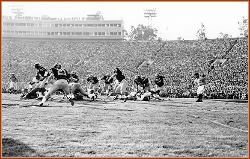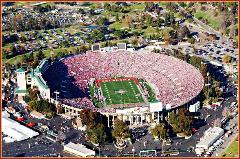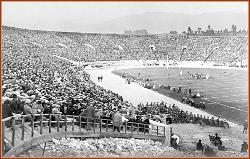



Raymond James Stadium is a football and soccer stadium located in Tampa, Florida. It is
home to the NFL's Tampa Bay Buccaneers as well as the University of South Florida
football team, and was formerly home to the MLS's Tampa Bay Mutiny. The stadium seats
just over 66,000, and it is expandable to 75,000 for special events, making it much
smaller than the stadiums in Gainesville, Miami and Tallahassee. The stadium also hosts
the annual Outback Bowl on New Year's Day, and the Superbowl of Motorsports monster
truck event in mid-January. Super Bowl XXXV was held there on January 28, 2001
between the Baltimore Ravens and New York Giants. It will host Super Bowl XLIII in 2009.
Raymond James Stadium was built primarily to replace the aging Houlihan's Stadium,
formerly located adjacent to the property. It is located on the former site of the now-
demolished Al Lopez Field. The stadium officially opened September 20, 1998, when the
Tampa Bay Buccaneers defeated the Chicago Bears, 27-15. The final cost of the stadium
was $168.5 million, publicly financed. It was known as Tampa Community Stadium during
construction, but the naming rights were bought for $32.5 million for a thirteen-year deal
by St. Petersburg-based Raymond James Financial in June 1998. On April 27, 2006 an
extension was signed to maintain naming rights through 2015.
One of the most recognizable features of the stadium is a 103-foot, 43-ton steel-and-
concrete replica pirate ship, which fires soft-rubber footballs and confetti each time that
the Bucs score points. The cannons fire six times for a touchdown, once for an extra point
or if the Bucs get into their opponent's red zone, twice for a safety or two point
conversion, and three times for a field goal. In addition, when the Buccaneers enter their
opponent's red zone, stadium hosts hoist team flags around the perimeter of the upper
deck.
When it opened, Raymond James Stadium was dubbed the "crown jewel" of the NFL. Buc
Vision, a pair of 92-foot wide video screens, are among the largest in the league.
Buccaneer Cove features a weathered, two-story fishing village facade, housing stadium
concessions and restrooms. All areas of the stadium are ADA compliant.
Temporary bleachers were erected in the endzones for Super Bowl XXXV, and the
attendance was a stadium record 71,921.
In 2003, the corner billboards in the stadium were replaced with rotating trilon billboards.
Historical Notes about the Stadium
On September 3, 1996, the voters of Hillsborough County, Florida approved, by 53% to
47% margin, a thirty-year, half-cent sales tax to build new schools, improve public safety
and infrastructure, along with building the new stadium. Voting precincts reported record
turnout.
On October 31, 1996, the NFL owners met in New Orleans to select the host site for
Super Bowl XXXIII and Super Bowl XXXIV. Pro Player Stadium in the Miami area was
selected to host Super Bowl XXXIII. Atlanta, Tempe and Tampa were candidates for Super
Bowl XXXIV, with Tampa the favorite, following the successful tax referendum. The
Georgia Dome in Atlanta, however, was awarded the game. As a compromise, Tampa
was awarded Super Bowl XXXV, which the NFL had not originally planned to select that
day.
On May 25, 2005, NFL owners met in Washington, D.C. to select the host site for Super
Bowl XLIII. During the balloting, Raymond James Stadium defeated the Georgia Dome
(Atlanta), Reliant Stadium (Houston), and Dolphin Stadium (Miami Gardens).
After a nearly two-year legal battle, the Tampa Sports Authority came to a settlement with
popular sports-seating and telescopic platform/bleacher company Hussey Seating of
North Berwick, Maine. Following the stadium’s opening in 1998, roughly 50,000 Hussey-
manufactured seats at Raymond James Stadium began to fade from their original color –
a bright, vibrant shade of red – to a shade of washed-out pink. Spotting this obvious
defect, the Buccaneers organization pleaded to the TSA to sue the seating
manufacturing company for the cost to replace the affected chairs in 2003. Initially, in
May of 2004, after testing samples of the seats, Hussey Seating did not find any cause
for the fading, and thus, found no reason to replace the seats at the company’s cost
under the current 10-year warranty. After the TSA cited a portion of the warranty which
did, in fact, state that Hussey would replace seats if any fading were to occur, Hussey
president Tim Hussey admitted an error in the research and eventually would come to a
$1.5-million agreement with the TSA to replace the problem seats. Reportedly, the seat-
fading occurred due to a manufacturing error by Hussey, as a UV inhibitor – a sunscreen-
like component for the plastic – was forgotten in the mixture used to create the seats. All
of the problem seats were replaced by new, non-pink seats in the spring of 2006.
Although there are no official nicknames, the stadium is sometimes referred to as "Ray
Jay", "The New Sombrero" (a spinoff of the former Bucs' home, as coined by Chris
Berman of ESPN), or humorously by local residents as "the CITS", which stands for the
Community Investment Tax Stadium. The name coming from the tax referendum that was
created to fund its construction. On occasions during radio broadcasts of games,
Buccaneer's Radio Network and Seminole's Radio Network commentator Gene
Deckerhoff refers to the stadium as Jesse James Stadium.




Biggest Football Games Played at Raymond James
Super Bowls
Super Bowl XXXV: January 28, 2001 (Baltimore
Ravens 34, New York Giants 7)
Super Bowl XLIII: February 1, 2009
NFL Playoff Games
NFC Divisional Playoff: January 15, 2000 (Tampa Bay
Buccaneers 14, Washington Redskins 13)
NFC Divisional Playoff: January 12, 2003 (Tampa Bay
Buccaneers 31, San Francisco 49ers 6)
NFC Wild Card Playoff: January 7, 2006 (Washington
Redskins 17, Tampa Bay Buccaneers 10)
|








